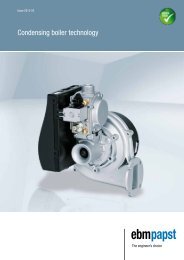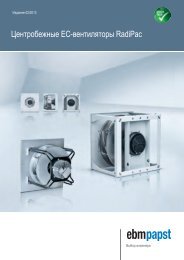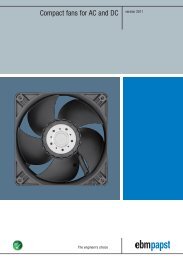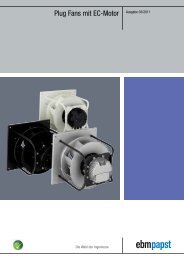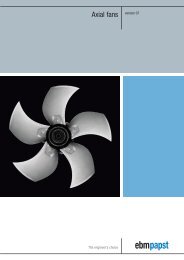Drive technology for AC and DC
Drive technology for AC and DC
Drive technology for AC and DC
You also want an ePaper? Increase the reach of your titles
YUMPU automatically turns print PDFs into web optimized ePapers that Google loves.
Definitions <strong>for</strong> EC motorsAll in<strong>for</strong>mation is based on the measuring conditions mentioned below. The values mentioned aretypical values <strong>for</strong> the design in question <strong>and</strong> are also subject to the tolerances included in the specificationdrawings. Unless otherwise stated, the supplements <strong>and</strong> safety notes contained in therelevant manual <strong>and</strong> / or in the specification drawings must be observed at all times.Nominal voltage U BN [V <strong>DC</strong>]The <strong>DC</strong> voltage that is applied to the commutation electronics as asystem supply voltage. All nominal values listed in the technical tables ofthe individual motors refer to this voltage. The system can, however, beoperated at other voltages within limits defined at the lower end by thereliability of the electronic components at low voltages <strong>and</strong> at the higherend by the mechanical speed limitations of the motor <strong>and</strong> ability of theelectronic components to survive the high voltages <strong>and</strong> currents. Formotors with integrated operating electronics, the permissible operatingvoltage range is determined by the electronics. For these motors, the permittedrange is specified as an additional table value. For drive systemsthat have a separate supply <strong>for</strong> power <strong>and</strong> logic (example: V<strong>DC</strong>-3-49.15),the nominal voltage is called UN, which applies to both the power <strong>and</strong>logic supply. The designation UB is then used <strong>for</strong> the low-power logicsupply of these drives. The ripple of the supply voltage should not exceed3.5 %, as higher ripple means poorer efficiency <strong>and</strong> control quality.Nominal speed n N [rpm]The speed at which the motor may be operated continuously whiledelivering nominal torque at an ambient temperature of 40 °C <strong>and</strong> nominaloutput torque. It is an operating point on the max. motor curve basedon an ideal electronics with negligible losses. When using an electronicswith non-negligible losses or with PWM-pulsing, the nominal speed thatcan be achieved is reduced accordingly when the supply voltage remainsconstant..Nominal torque M N [mNm]The torque that the motor can deliver continuously at an ambient temperatureof 40 °C <strong>and</strong> nominal speed.Nominal current I BN [A]The current that is drawn from the system supplywhen the motor delivers nominal torque at nominalspeed. For drive systems that have a separate supply<strong>for</strong> power <strong>and</strong> logic (example: V<strong>DC</strong>-3-49.15),the nominal current is called I N . This nominal currentis the sum of the power supply (I ZK ) <strong>and</strong> thelow-power logic supply (I B ). The actual current thatcreates the torque is the current that flows in themotor lads, (Nominal current effective in the supply=I Neff ) it is generated by the operating electronicsas output current. Due to the influence of the operatingelectronics in use (operating efficiency of theelectronics <strong>and</strong> PWM pulsing), a certain deviationto the nominal current from the system supply ispossible.The illustratedcurves are idealizedrepresentationsbased onthe figures in thetables.Compact drive<strong>AC</strong> <strong>DC</strong> Commutation sequencesSystem VoltageMotorSupplyM ain SupplyTrans<strong>for</strong>merElectronicsMotorU BN –I BN –I BL –P Bn0 I n0eff –I max –I Neff (each Phase)U N –I N –I L R V –L V –U i max (Phase to Phase)n N -n LM N -M Bn0P N -M max152



